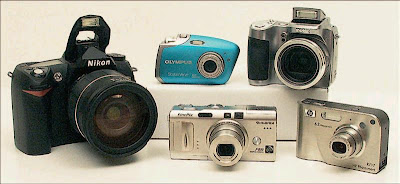As shown in Figure 1-1, digital cameras come in all shapes and sizes. (You can see additional cameras throughout the next several chapters.) But although designs and features differ from model to model, all digital cameras are created to accomplish the same goal: to simplify the process of creating digital images.
 |
| Figure 1-1: These models from Nikon, Olympus, Kodak, Fujifilm, and HP illustrate the variety of digital cameras. |
When I speak of a digital image, Iím referring to a picture that you can view and edit on a computer. Digital images, like anything else you see on your computer screen, are nothing more than bits of electronic data. Your computer analyzes that data and displays the image on-screen. (For a detailed look at how digital images work, see Chapter 2.)
Digital images are nothing new - people have been creating and editing digital pictures using such programs as Adobe Photoshop for years. But until the advent of digital cameras, getting a stunning sunset scene or an endearing baby picture into digital form required some time and effort. After shooting the picture with a film camera, you had to get the film developed and then have the photographic print or slide digitized (that is, converted to a computer image) using a piece of equipment known as a scanner. Assuming that you weren't well-off enough to have a darkroom and a scanner in the east wing of your mansion, this process could take several days and involve several middlemen and associated middleman costs.
Digital cameras provide an easier, more convenient option. While traditional cameras capture images on film, digital cameras record what they see using computer chips and digital storage devices, creating images that you can immediately access on your computer. No film, film processing, or scanning is involved - you press the shutter button, and voila: You have a digital image. To use the image, you simply transfer it from your camera to the computer, which you can do in a variety of ways. With the latest digital cameras, you can send your pictures directly to a photo printer - you don't even need a computer!

Post a Comment